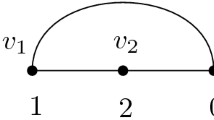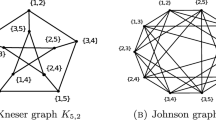Abstract
Let \(f:V \rightarrow \{0,1,2\}\) be a function, \(G=(V,E)\) be a graph with a vertex set V and a set of edges E and let the weight of the vertex \(u \in V\) be defined by f(u). A vertex u with property \(f(u)=0\) is considered to be defended with respect to the function f if it is adjacent to a vertex with positive weight. Further, the function f is called a weak Roman dominating function (WRDF) if for every vertex u with property \(f(u)=0\) there exists at least one adjacent vertex v with positive weight such that the function \(f':V \rightarrow \{0,1,2\}\) defined by \(f'(u)=1\), \(f'(v)=f(v)-1\) and \(f'(w)=f(w)\), \(w \in V \setminus \{u,v\}\) has no undefended vertices. In this paper, an optimization problem of finding the WRDF f such that \(\sum _{u \in V}{f(u)}\) is minimal, known as the weak Roman domination problem (WRDP), is considered. Therefore, a new integer linear programing (ILP) formulation is proposed and compared with the one known from the literature. Comparison between the new and the existing formulation is made through computational experiments on a grid, planar, net and randomly generated graphs known from the literature and up to 600 vertices. Tests were run using standard CPLEX and Gurobi optimization solvers. The obtained results demonstrate that the proposed new ILP formulation clearly outperforms the existing formulation in the sense of solutions’ quality and running times.
Similar content being viewed by others
Explore related subjects
Discover the latest articles, news and stories from top researchers in related subjects.References
Ahangar HA, Henning MA, Löwenstein C, Zhao Y, Samodivkin V (2014) Signed roman domination in graphs. J Comb Optim 27(2):241–255
Alvarado JD, Dantas S, Rautenbach D (2015a) Relating \(2\)-rainbow domination to weak roman domination. arXiv preprint arXiv:1512.01067
Alvarado JD, Dantas S, Rautenbach D (2015b) Strong Equality of Roman and Weak Roman Domination in Trees. arXiv preprint arXiv:1507.04901
Alvarez-Ruiz M, Yero IG, Mediavilla-Gradolph T, Valenzuela J (2015) A stronger vision for roman domination in graphs. arXiv preprint arXiv:1502.03933
Burger A, De Villiers A, Van Vuuren J (2013) A binary programming approach towards achieving effective graph protection. In: Proceedings of the 2013 ORSSA annual conference, ORSSA, 2013, pp 19–30
Chang GJ, Chen SH, Liu CH (2014) Edge roman domination on graphs. arXiv preprint arXiv:1405.5622
Chapelle M, Cochefert M, Couturier JF, Kratsch D, Liedloff M, Perez A (2013) Exact algorithms for weak roman domination. In: Combinatorial Algorithms, Springer, pp 81–93
Chellali M, Haynes TW, Hedetniemi ST (2014) Bounds on weak roman and 2-rainbow domination numbers. Discrete Appl Math 178:27–32
Cockayne E, Grobler P, Grundlingh W, Munganga J, Jv Vuuren (2005) Protection of a graph. Util Math 67:19–32
Currò V (2014) The roman domination problem on grid graphs. Ph.D. thesis, Università di Catania
Dreyer PA Jr (2000) Applications and variations of domination in graphs. Ph.D. thesis, Citeseer
Henning MA (2003) Defending the roman empire from multiple attacks. Discret Math 271(1):101–115
Henning MA, Hedetniemi ST (2003) Defending the roman empire a new strategy. Discret Math 266(1):239–251
Klobučar A, Puljić I (2014) Some results for roman domination number on cardinal product of paths and cycles. Kragujev J Math 38(1):83–94
Lai YL, Lin CT, Ho HM (2011) Weak roman domination on graphs. In: Proceedings of the 28th workshop on combinatorial mathematics and computation theory, Penghu University of Science and Technology, Penghu, Taiwan, May 27–28, 2011, pp 224–214
Liedloff M, Kloks T, Liu J, Peng SL (2005) Roman domination over some graph classes. In: Graph-Theoretic Concepts in Computer Science, Springer, pp 103–114
Liu CS, Peng SL, Tang CY (2010) Weak Roman Domination on Block Graphs. In: Proceedings of The 27th workshop on combinatorial mathematics and computation theory, Providence University, Taichung, Taiwan, April 30–May 1, 2010, pp 86–89
Pushpam PRL, Kamalam M (2015) Efficient weak roman domination in myscielski graphs. Int J Pure Eng Math (IJPEM) 3(2):93–100
Pushpam PRL, Kamalam M (2015) Efficient weak roman domination in graphs. Int J Pure Appl Math 101(5):701–710
Pushpam PRL, Mai TM (2011) Weak roman domination in graphs. Discuss Math Graph Theory 31(1):161–170
ReVelle CS, Rosing KE (2000) Defendens imperium romanum: a classical problem in military strategy. Am Math Mon 107(7):585–594
Shang W, Hu X (2007) The roman domination problem in unit disk graphs. In: Computational Science–ICCS 2007, Springer, pp 305–312
Song X, Yang J, Xie Y (2011) Weak Roman domination in 2xn grid graphs. J Henan Univ (Nat Sci) 41(1): 4–9 (in Chinese)
Song X, Bian J, Yin W (2013) Six safe grades on weak roman domination. J Henan Univ (Nat Sci) 5:002
Stewart I (1999) Defend the roman empire!. Sci Am 281:136–138
Targhi M, Rad NJ, Moradi MS (2012) Properties of independent roman domination in graphs. Australas J Combin 52:11–18
Author information
Authors and Affiliations
Corresponding author
Ethics declarations
Conflict of interest
The author declares that there is no conflict of interest regarding the publication of this paper.
Additional information
Communicated by V. Loia.
This research was partially supported by the Serbian Ministry of Education, Science and Technological Developments under the Grant No. TR36006.
Electronic supplementary material
Below is the link to the electronic supplementary material.
Rights and permissions
About this article
Cite this article
Ivanović, M. Improved integer linear programming formulation for weak Roman domination problem. Soft Comput 22, 6583–6593 (2018). https://doi.org/10.1007/s00500-017-2706-4
Published:
Issue Date:
DOI: https://doi.org/10.1007/s00500-017-2706-4




